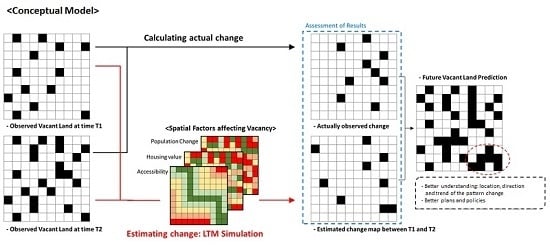Forecasting Urban Vacancy Dynamics in a Shrinking City: A Land Transformation Model
Abstract
:1. Introduction
2. Literature Review
2.1. Definition of Vacant Land
2.2. Causes and Impacts of Vacant and Abandoned Properties
2.3. The Land Transformation Model
3. Literature Gaps and Research Objectives
4. Materials and Methods
4.1. Study Area and Data
4.2. Variable Selection
4.3. Methodology
4.3.1. LTM
4.3.2. Accuracy and Reliability
5. Results
5.1. LTM Output Statistics
5.2. Statistical Vacant Land Clustering: Pattern Density and Hot Spot Analysis
6. Conclusions and Discussion
Acknowledgments
Author Contributions
Conflicts of Interest
References
- Department Economic United Nations. World Population Prospects: the 2012 Revision; Population Division of the Department of Economic and Social Affairs of the United Nations Secretariat: New York, NY, USA, 2013. [Google Scholar]
- Grimm, N.B.; Faeth, S.H.; Golubiewski, N.E.; Redman, C.L.; Wu, J.; Bai, X.; Briggs, J.M. Global change and the ecology of cities. Science 2008, 319, 756–760. [Google Scholar] [CrossRef] [PubMed]
- Grekousis, G.; Mountrakis, G. Sustainable development under population pressure: Lessons from developed land consumption in the conterminous US. PLoS ONE 2015, 10, e0119675. [Google Scholar] [CrossRef] [PubMed]
- Downs, A. Some realities about sprawl and urban decline. Hous. Pol. Debate 1999, 10, 955–974. [Google Scholar]
- Pallagst, K. Shrinking Cities Planning Challenges from an International Perspective Clevelant; Kent State University and Cleveland Urban Design Collaborative: Kent, OH, USA, 2008. [Google Scholar]
- Reckien, D.; Martinez-Fernandez, C. Why do cities shrink? Eur. Plan. Stud. 2011, 19, 1375–1397. [Google Scholar] [CrossRef]
- Schilling, J.; Logan, J. Greening the rust belt: A green infrastructure model for right sizing America’s shrinking cities. J. Am. Plan. Assoc. 2008, 74, 451–466. [Google Scholar] [CrossRef]
- Accordino, J.; Johnson, G.T. Addressing the vacant and abandoned property problem. J. Urban Aff. 2000, 22, 301–315. [Google Scholar] [CrossRef]
- Hollander, J.B.; Pallagst, K.; Schwarz, T.; Popper, F. Planning shrinking cities. Prog. Plan. 2009, 72, 223–232. [Google Scholar]
- Pagano, M.; Bowman, A. Vacant Land as Opportunity and Challenge. In Recycling the City: The Use and Reuse of Urban Land; Lincoln Institute: Cambridge, MA, USA, 2004; pp. 15–32. [Google Scholar]
- Bowman, A.O.M.; Pagano, M.A. Transforming America’s cities: Policies and conditions of vacant land. Urban Aff. Rev. 2000, 35, 559–581. [Google Scholar] [CrossRef]
- Bass, M.; Chen, D.; Leonard, J.; Leonard, J.; Mueller, L.; Cheryl, L.; McCann, B.; Moravec, A.; Schilling, J.; Snyder, K. Vacant Properties: The True Costs to Communities; National Vacant Properties Campaign: Washington, DC, USA, 2005. [Google Scholar]
- Pagano, M.A.; Bowman, A.O.M. Vacant Land in Cities: An Urban Resource; Brookings Institution Center on Urban and Metropolitan Policy: Washington, DC, USA, 2000. [Google Scholar]
- Goldstein, J.; Jensen, M.; Reiskin, E. Urban Vacant Land Redevelopment: Challenges and Progress; Citeseer: Cambridge, MA, USA, 2001. [Google Scholar]
- Immergluck, D.; Smith, G. The impact of single-family mortgage foreclosures on neighborhood crime. Hous. Stud. 2006, 21, 851–866. [Google Scholar] [CrossRef]
- Sternlieb, G.; Burchell, R.W.; Hughes, J.W.; James, F.J. Housing abandonment in the urban core. J. Am. Inst. Plan. 1974, 40, 321–332. [Google Scholar] [CrossRef]
- Cui, L.; Walsh, R. Foreclosure, vacancy and crime. J. Urban Econ. 2015, 87, 72–84. [Google Scholar] [CrossRef]
- Han, H.S. The impact of abandoned properties on nearby property values. Hous. Pol. Debate 2014, 24, 311–334. [Google Scholar] [CrossRef]
- Spelman, W. Abandoned buildings: Magnets for crime? J. Crim. Justice 1993, 21, 481–495. [Google Scholar] [CrossRef]
- Newman, G.; Lee, J.; Berke, P. Using the land transformation model to forecast vacant land. J. Land Use Sci. 2016, 11, 450–475. [Google Scholar] [CrossRef]
- Pijanowski, B.; Shellito, B.; Bauer, M.; Sawaya, K. Using GIS Artificial Neural Networks and Remote Sensing to Model Urban Change in the Minneapolis–St. Paul and Detroit Metropolitan area. Proceedings of American Society of Photogrammetry and Remote Sensing Annual Conference, St. Louis, MO, USA, 23–27 April 2001. [Google Scholar]
- Pijanowski, B.C.; Tayyebi, A.; Doucette, J.; Pekin, B.K.; Braun, D.; Plourde, J. A big data urban growth simulation at a national scale: configuring the GIS and neural network based land transformation model to run in a high performance computing (HPC) environment. Environ. Model. Softw. 2014, 51, 250–268. [Google Scholar] [CrossRef]
- Pijanowski, B.C.; Brown, D.G.; Shellito, B.A.; Manik, G.A. Using neural networks and GIS to forecast land use changes: a land transformation model. Comput. Environ. Urban Syst. 2002, 26, 553–575. [Google Scholar] [CrossRef]
- Tayyebi, A.; Perry, P.C.; Tayyebi, A.H. Predicting the expansion of an urban boundary using spatial logistic regression and hybrid raster–vector routines with remote sensing and GIS. Int. J. Geogr. Inf. Sci. 2014, 28, 639–659. [Google Scholar] [CrossRef]
- Almeida, C.; Gleriani, J.; Castejon, E.F.; Soares-Filho, B. Using neural networks and cellular automata for modelling intra-urban land-use dynamics. Int. J. Geogr. Inf. Sci. 2008, 22, 943–963. [Google Scholar] [CrossRef]
- Brown, D.G.; Pijanowski, B.C.; Duh, J. Modeling the relationships between land use and land cover on private lands in the Upper Midwest, USA. J. Environ. Manag. 2000, 59, 247–263. [Google Scholar] [CrossRef]
- Tang, Z.; Engel, B.; Pijanowski, B.; Lim, K. Forecasting land use change and its environmental impact at a watershed scale. J. Environ. Manag. 2005, 76, 35–45. [Google Scholar] [CrossRef] [PubMed]
- Ray, D.K.; Pijanowski, B.C. A backcast land use change model to generate past land use maps: Application and validation at the Muskegon River watershed of Michigan, USA. J. Land Use Sci. 2010, 5, 1–29. [Google Scholar] [CrossRef]
- Drake, L.; Lawson, L.J. Validating verdancy or vacancy? The relationship of community gardens and vacant lands in the US. Cities 2014, 40, 133–142. [Google Scholar] [CrossRef]
- Park, I.K.; Von Rabenau, B. Tax delinquency and abandonment: An expanded model with application to industrial and commercial properties. Urban Stud. 2015, 52, 857–875. [Google Scholar] [CrossRef]
- Agarwal, C.; Green, G.M.; Grove, J.M.; Evans, T.P.; Schweik, C.M. A Review and Assessment of Land-Use Change Models: Dynamics of Space, Time, and Human Choice; Gen. Tech. Rep. NE-297; U.S. Department of Agriculture, Forest Service, Northeastern Research Station: Newton Square, PA, USA, 2002; 61p.
- Brown, D.G.; Duh, J.D. Spatial simulation for translating from land use to land cover. Int. J. Geogr. Inf. Sci. 2004, 18, 35–60. [Google Scholar] [CrossRef]
- Verburg, P.H.; Schot, P.P.; Dijst, M.J.; Veldkamp, A. Land use change modelling: current practice and research priorities. GeoJournal 2004, 61, 309–324. [Google Scholar] [CrossRef]
- Basse, R.M.; Omrani, H.; Charif, O.; Gerber, P.; Bódis, K. Land use changes modelling using advanced methods: cellular automata and artificial neural networks. The spatial and explicit representation of land cover dynamics at the cross-border region scale. Appl. Geogr. 2014, 53, 160–171. [Google Scholar] [CrossRef]
- Grekousis, G.; Manetos, P.; Photis, Y.N. Modeling urban evolution using neural networks, fuzzy logic and GIS: The case of the Athens metropolitan area. Cities 2013, 30, 193–203. [Google Scholar] [CrossRef]
- Conway, T. The impact of class resolution in land use change models. Comput. Environ. Urban Syst. 2009, 33, 269–277. [Google Scholar] [CrossRef]
- Landis, J.D. Urban growth models: State of the art and prospects. In Global Urbanization; University of Pennsylvania Press: Philadelphia, PA, USA, 2011; pp. 126–150. [Google Scholar]
- Bowman, A.O.M. Terra Incognita: Vacant Land and Urban Strategies; Georgetown University Press: Washington, DC, USA, 2004. [Google Scholar]
- Glaeser, E.L.; Gyourko, J.; Saks, R.E. Urban growth and housing supply. J. Econ. Geogr. 2006, 6, 71–89. [Google Scholar] [CrossRef]
- Németh, J.; Langhorst, J. Rethinking urban transformation: Temporary uses for vacant land. Cities 2014, 40, 143–150. [Google Scholar] [CrossRef]
- Chicago Metropolitan Agency for Planning. 2010 Land Use Inventory: Classification Scheme. Available online: https://datahub.cmap.illinois.gov/dataset/land-use/resource/4102165e-e327-412b-bde2-ebd4a8295f6d (accessed on 27 May 2016).
- Squires, G.D.; Bennett, L.; McCourt, K. Chicago: Race, Class, and the Response to Urban Decline; Temple University Press: Philadelphia, PA, USA, 1989. [Google Scholar]
- Cox, W. The Evolving Urban Form: Chicago. 2011. Available online: http://www.newgeography.com/content/002346-the-evolving-urban-form-chicago (accessed on 2 June 2016).
- U.S. Census Bureau. Chicago City QuickFacts. Available online: https://www.census.gov/quickfacts/map/IPE120213/1714000/accessible (accessed on 21 May 2016).
- Will The Foreclosure Crisis Kill Chicago? Available online: http://www.chicagobusiness.com/article/20131109/ISSUE01/311099980/will-the-foreclosure-crisis-kill-chicago (accessed on 21 February 2016).
- Buhnik, S. From shrinking cities to Toshi no Shukushō: Identifying patterns of urban shrinkage in the Osaka metropolitan area. Berkeley Plan. J. 2010, 23, 132–155. [Google Scholar]
- Lindsey, C. Smart decline. In Panorama: What’s New in Planning; University of Pennsylvania Press: Philadelphia, PA, USA, 2007. [Google Scholar]
- Rieniets, T. Shrinking cities: Causes and effects of urban population losses in the twentieth century. Nat. Cult. 2009, 4, 231–254. [Google Scholar] [CrossRef]
- Bontje, M. Facing the challenge of shrinking cities in East Germany: The case of Leipzig. GeoJournal 2005, 61, 13–21. [Google Scholar] [CrossRef]
- Johnson, M.P.; Hollander, J.; Hallulli, A. Maintain, demolish, re-purpose: Policy design for vacant land management using decision models. Cities 2014, 40, 151–162. [Google Scholar] [CrossRef]
- Ryan, B.D. Design after Decline: How America Rebuilds Shrinking Cities; University of Pennsylvania Press: Philadelphia, PA, USA, 2012. [Google Scholar]
- Audirac, I. Urban Shrinkage Amid Fast Metropolitan Growth (Two Faces of Contemporary Urbanism). 2007. Available online: http://metrostudies.berkeley.edu/pubs/proceedings/Shrinking/10Audirac_PA_final.pdf (accessed on 2 December 2015).
- Cunningham-Sabot, E.; Fol, S. Shrinking cities in France and Great Britain: A silent process. In The Future of Shrinking Cities: Problems, Patterns and Strategies of Urban Transformation in a Global Context; Center for Global Metroplitan Studies: Berkeley, CA, USA, 2009; pp. 17–28. [Google Scholar]
- Rybczynski, W.; Linneman, P.D. How to save our shrinking cities. Public Interest 1999, 135, 30–44. [Google Scholar]
- Henry, M.S.; Schmitt, B.; Piguet, V. Spatial econometric models for simultaneous systems: Application to rural community growth in France. Int. Reg. Sci. Rev. 2001, 24, 171–193. [Google Scholar] [CrossRef]
- Hollander, J.B.; Németh, J. The bounds of smart decline: A foundational theory for planning shrinking cities. Hous. Pol. Debate 2011, 21, 349–367. [Google Scholar] [CrossRef]
- Clark, K.; Drinkwater, S. Enclaves, neighbourhood effects and employment outcomes: Ethnic minorities in England and Wales. J. Popul. Econ. 2002, 15, 5–29. [Google Scholar] [CrossRef]
- Fee, K.; Hartley, D. Economic Trends: Growing Cities, Shrinking Cities. Available online: http://www.clevelandfed.org/newsroom-and-events/publications/economic-trends/2011-economic-trends/et-20110414-growing-cities-shrinking-cities.aspx (accessed on 2 June 2016).
- Long, H.U.S. Has Lost 5 Million Manufacturing Jobs Since 2000. Available online: http://money.cnn.com/2016/03/29/news/economy/us-manufacturing-jobs/ (accessed on 21 January 2016).
- Mallach, A.; Brachman, L. Shaping Federal Policies Toward Cities in Transition: A Policy Brief; Greater Ohio Policy Center: Columbus, OH, USA, 2010. [Google Scholar]
- Glaeser, E.L. A Nation of Gamblers: Real Estate Speculation and American History (Feb. 2013). Am. Econ. Rev. 2013, 103, 1–42. [Google Scholar] [CrossRef]
- Mallach, A. Depopulation, market collapse and property abandonment: Surplus land and buildings in legacy cities. In Rebuilding America’s Legacy Cities: New Directions for the Industrial Heartland; American Assembly, Columbia University: New York, NY, USA, 2012; pp. 85–110. [Google Scholar]
- Massey, D.S.; Denton, N.A. American Apartheid: Segregation and the Making of the Underclass; Harvard University Press: Cambridge, MA, USA, 1993. [Google Scholar]
- Sugrue, T.J. The origins of the urban crisis: Race and Inequality in Postwar Detroit; Princeton University Press: Princeton, NJ, USA, 2014. [Google Scholar]
- Hollander, J.B. Moving toward a shrinking cities metric: Analyzing land use changes associated with depopulation in Flint, Michigan. Cityscape 2010, 12, 133–151. [Google Scholar] [CrossRef]
- U.S. Census Bureau. Quarterly Residential Vacancies and Homeownership, Fourth Quarter 2016. Available online: https://www.census.gov/housing/hvs/files/currenthvspress.pdf (accessed on 12 February 2017).
- Lester, T.W.; Kaza, N.; Kirk, S. Making room for manufacturing: Understanding industrial land conversion in cities. J. Am. Plan. Assoc. 2013, 79, 295–313. [Google Scholar] [CrossRef]
- Rappaport, J. US urban decline and growth, 1950 to 2000. Econ. Rev.-Fed. Reserve Bank Kans. City 2003, 88, 15. [Google Scholar]
- Pontius, R.G.; Boersma, W.; Castella, J.C.; Clarke, K.; de Nijs, T.; Dietzel, C.; Duan, Z.; Fotsing, E.; Goldstein, N.; Kok, K. Comparing the input, output, and validation maps for several models of land change. Ann. Reg. Sci. 2008, 42, 11–37. [Google Scholar] [CrossRef]
- Bishop, C.M. Neural Networks for Pattern Recognition; Clarendon Press: Oxford, UK, 1995. [Google Scholar]
- Pijanowski, B.; Alexandridis, K.; Mueller, D. Modelling urbanization patterns in two diverse regions of the world. J. Land Use Sci. 2006, 1, 83–108. [Google Scholar] [CrossRef]
- Congalton, R.; Mead, R.A. A quantitative method to test for consistency and correctness in photointerpretation. Photogramm. Eng. Remote Sens. 1983, 49, 69–74. [Google Scholar]
- Pontius, R.G. Quantification error versus location error in comparison of categorical maps. Photogramm. Eng. Remote Sens. 2000, 66, 1011–1016. [Google Scholar]
- Pontius, R.G., Jr.; Millones, M. Death to Kappa: birth of quantity disagreement and allocation disagreement for accuracy assessment. Int. J. Remote Sen. 2011, 32, 4407–4429. [Google Scholar] [CrossRef]
- Tayyebi, A.; Pekin, B.K.; Pijanowski, B.C.; Plourde, J.D.; Doucette, J.S.; Braun, D. Hierarchical modeling of urban growth across the conterminous USA: developing meso-scale quantity drivers for the Land Transformation Model. J. Land Use Sci. 2013, 8, 422–442. [Google Scholar] [CrossRef]
- Pontius, R.G., Jr.; Batchu, K. Using the relative operating characteristic to quantify certainty in prediction of location of land cover change in India. Trans. GIS 2003, 7, 467–484. [Google Scholar] [CrossRef]
- Pontius, R.G., Jr.; Si, K. The total operating characteristic to measure diagnostic ability for multiple thresholds. Int. J. Geogr. Inf. Sci. 2014, 28, 570–583. [Google Scholar] [CrossRef]
- Pontius, R.G.; Schneider, L.C. Land-cover change model validation by an ROC method for the Ipswich watershed, Massachusetts, USA. Agric. Ecosyst. Environ. 2001, 85, 239–248. [Google Scholar] [CrossRef]
- Osborne, P.E.; Alonso, J.; Bryant, R. Modelling landscape-scale habitat use using GIS and remote sensing: A case study with great bustards. J. Appl. Ecol. 2001, 38, 458–471. [Google Scholar] [CrossRef]
- Rutherford, G.N.; Bebi, P.; Edwards, P.J.; Zimmermann, N.E. Assessing land-use statistics to model land cover change in a mountainous landscape in the European Alps. Ecol. Model. 2008, 212, 460–471. [Google Scholar] [CrossRef]
- Grubesic, T.H.; Murray, A.T. Detecting Hot Spots Using Cluster Analysis and GIS. In Proceedings of the Fifth Annual International Crime Mapping Research Conference, Dallas, TX, USA, 1–4 December 2001. [Google Scholar]
- Berger, A. Drosscape: Wasting Land Urban America; Princeton Architectural Press: Princeton, NJ, USA, 2007. [Google Scholar]
- Brophy, P.C.; Vey, J.S. Seizing City Assets: Ten Steps to Urban Land Reform. Available online: http://citeseerx.ist.psu.edu/viewdoc/download?doi=10.1.1.148.1390&rep=rep1&type=pdf (accessed on 27 March 2016).
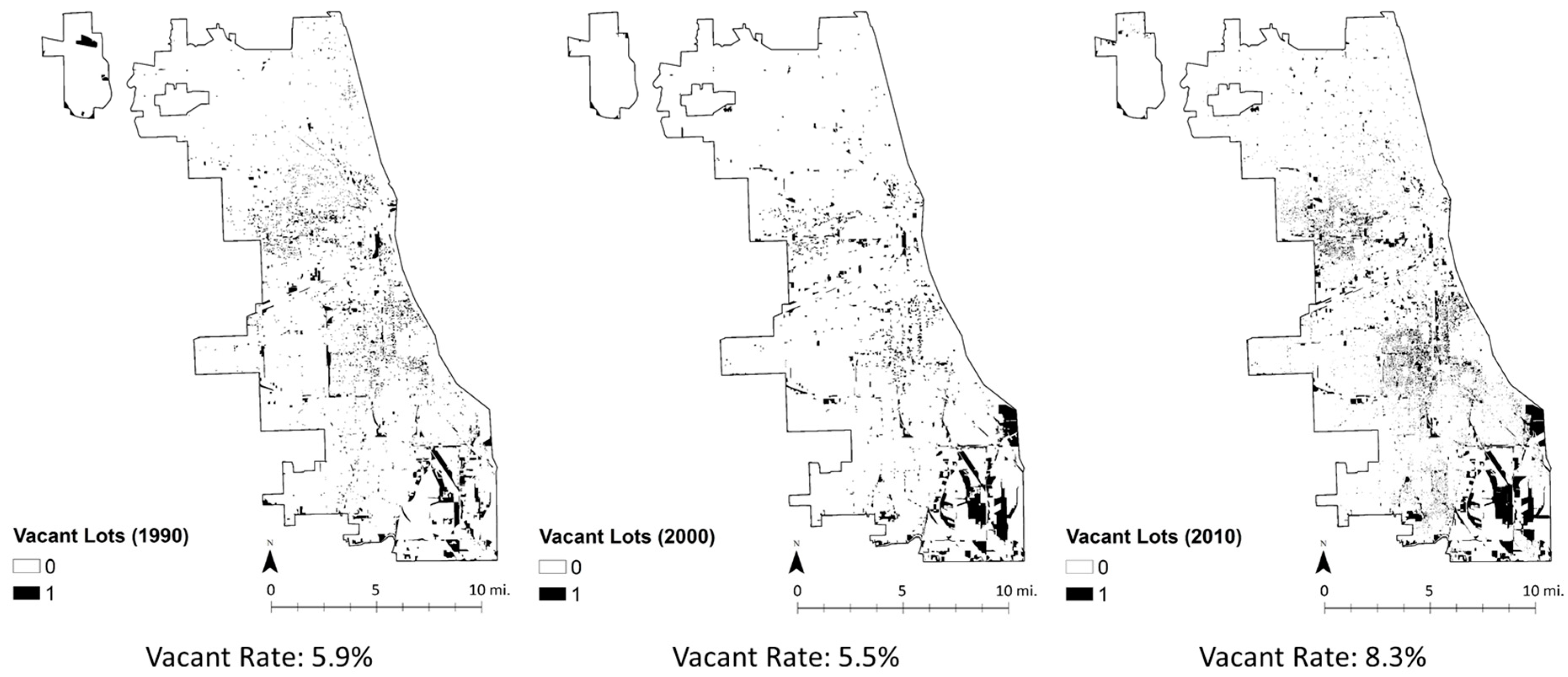

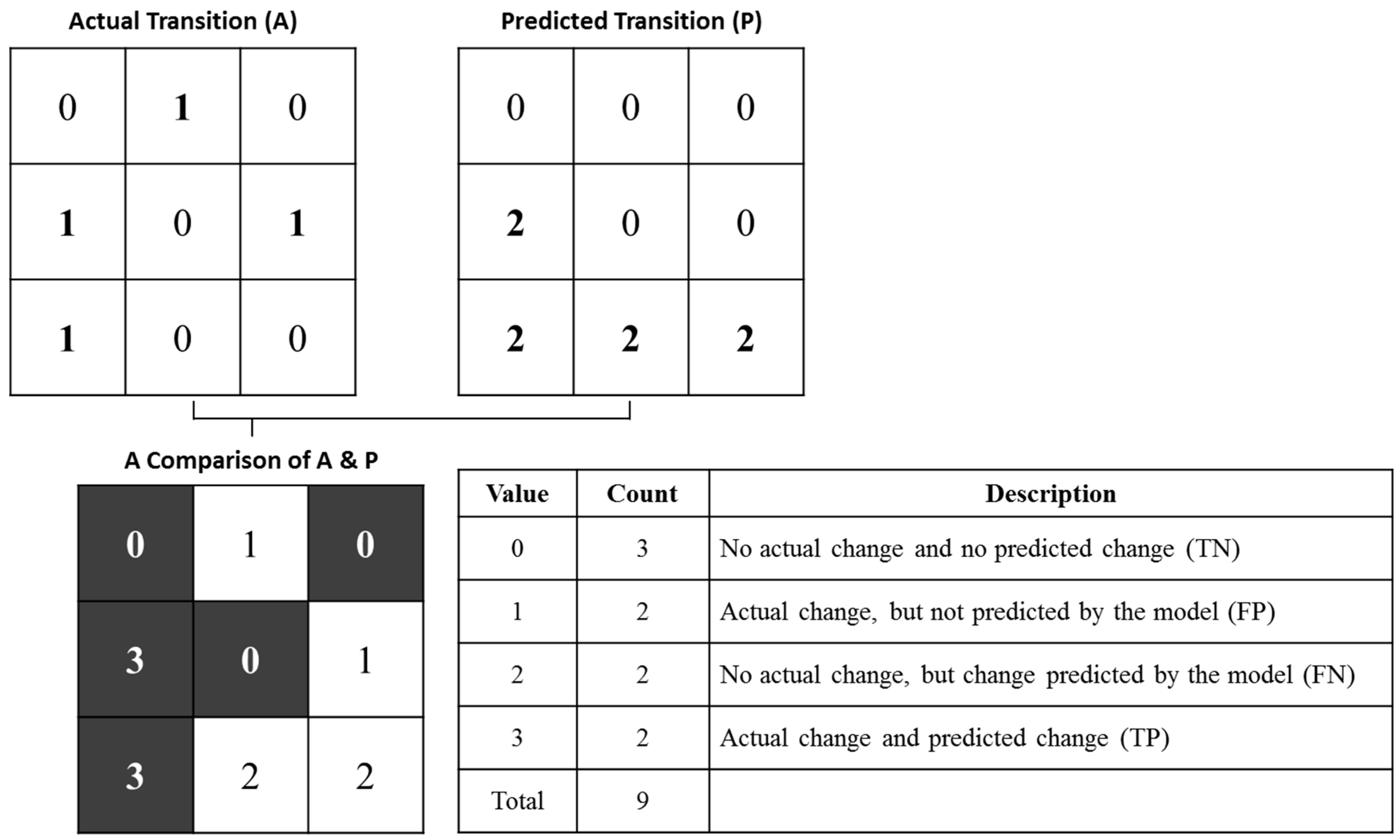
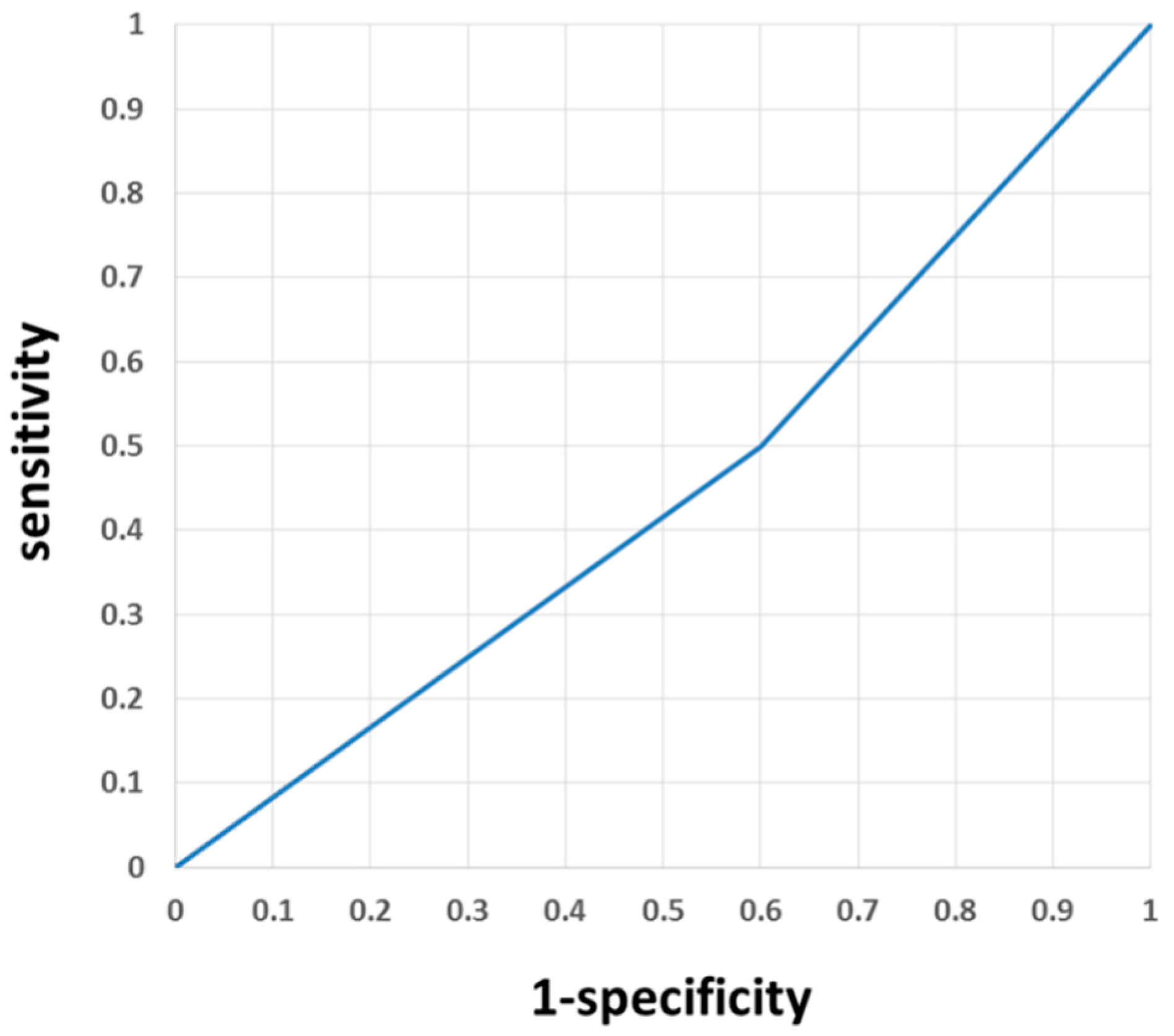

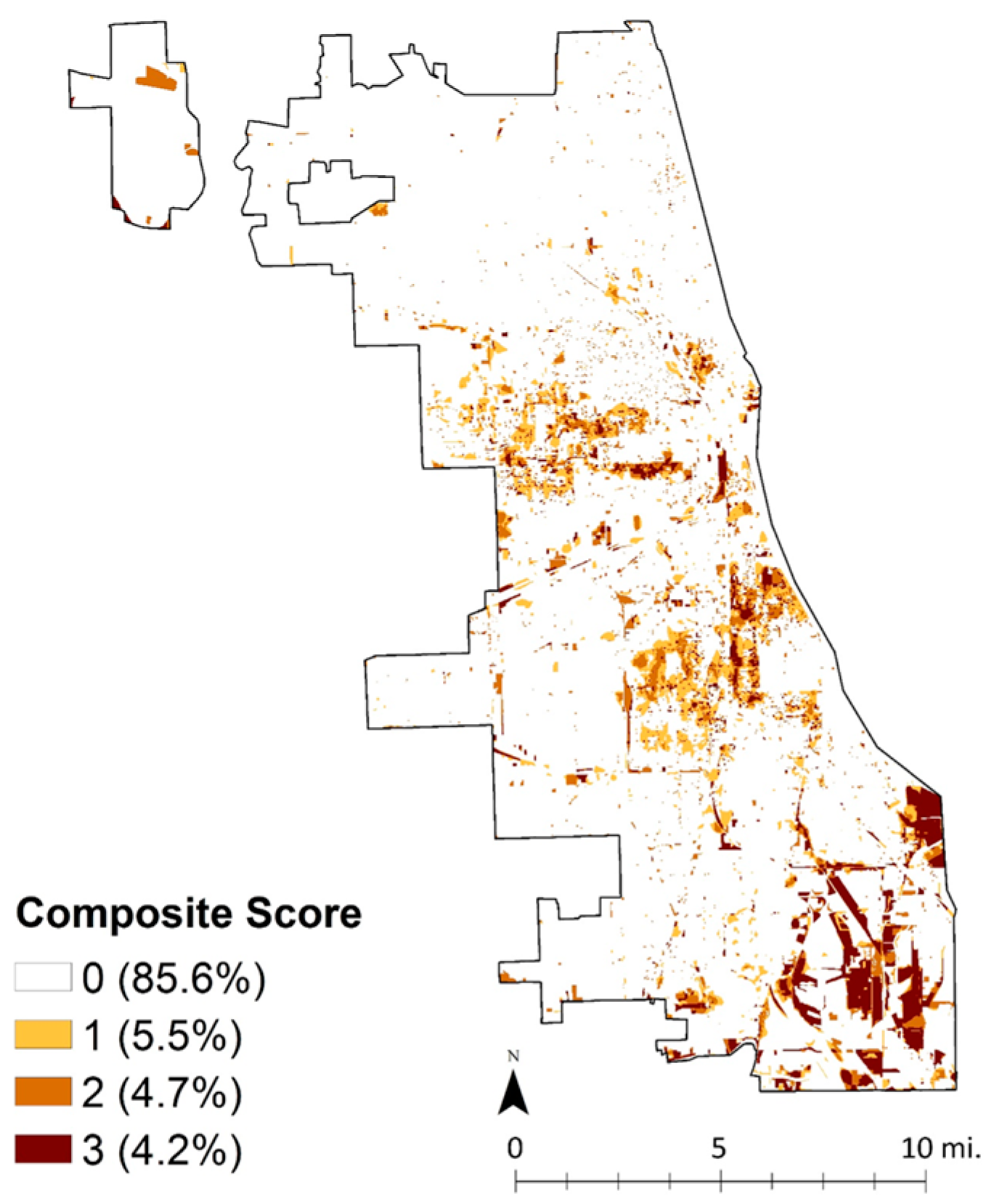

| City (State) | Population Change | Population Change (%) | |
|---|---|---|---|
| Top 5 Fastest Growing Cities | Fort Worth (TX) | 206,612 | 39% |
| Charlotte (NC) | 190,596 | 35% | |
| San Antonio (TX) | 182,761 | 16% | |
| New York (NY) | 166,855 | 2% | |
| Houston (TX) | 145,820 | 7% | |
| Top 5 Most Depopulating Cities | Cincinnati (OH) | −34,342 | −10% |
| Cleveland (OH) | −81,588 | −17% | |
| New Orleans (LA) * | −140,845 | −29% | |
| Chicago (IL) | −200,418 | −7% | |
| Detroit (MI) | −237,493 | −25% |
| Input Factors | Input Patterns | U.S. Census Definition | References for Input Factors | ||
|---|---|---|---|---|---|
| 90–00 | 90–10 | 00–10 | |||
| Unemployment Rate | O | O | O | Unemployment rate for civilian population in labor force 16 years and over | Fee & Hartley (2011), Mallach (2012), Aryeetey-Attoh et al. (2015) |
| Service Industry | O | O | O | Proportion of service industry to all industries | Fee & Hartley (2011), Glaeser (2013), Mallach (2012), Lester et al (2013), Glaeser & Kahn (2004), Cochrane et al (2013) |
| Secondary Industry | O | O | O | Proportion of secondary industry to all industries | Fee & Hartley (2011), Mallach (2012), Glaeser (2013), Glaeser & Kahn (2004), Wegener (1982), Dong (2013), Cochrane et al (2013) |
| Household Income | O | O | O | Median household income (Inflation adjusted dollars) | Ryan (2012), Fee & Hartley (2011), Glaeser (2013), Aryeetey-Attoh et al. (2015) |
| Education | O | O | O | Percent of persons 25 years of age and older, with less than or equal to high school graduate (includes equivalency) | Fee & Hartley (2011), Glaeser (2013), Mallach (2012), Parka & Cioricib (2015) |
| Poverty | O | O | O | Individual Poverty Rate: Individuals below poverty=”under 0.50” +“0.50 to 0.74” + “0.75 to 0.99.”) | Ryan (2012), Fee & Hartley (2011), Mallach & Brachman (2010) Glaeser (2013), Parka & Cioricib (2015) |
| Ethnicity | O | O | O | Non-white Population rate to total population | Ryan (2012), Fee & Hartley (2011), Massey and Denton (1993), Sugrue (1996), Hollander (2010) |
| Crime | O | Incidents of crime that occurred in the city | Cui & Walsh (2015). Spelman (1993), Kuo & Sulivan (2001), Jones & Pridemore (2013) | ||
| Home Ownership | O | O | O | Proportion of owner occupied housing units to all occupied housing units | Bradfort (1979), Pond & Yeates (2013), Aryeetey-Attoh et al. (2015), Parka & Cioricib (2015), Hoyt (1993), Temkin & Rohe (1996) |
| Housing Value | O | O | O | Median house value for all owner-occupied housing units | Glaeser & Gyourko (2001), Capozza & Helsley (1989), Dong (2013), Aryeetey-Attoh et al. (2015), Hollander (2010) |
| Mobile Homes | O | O | O | Mobile home rates to all housing units | Glaeser & Gyourko (2001), Hollander (2010), Capozza & Helsley (1989), Dong (2013), Aryeetey-Attoh et al. (2015) |
| Vacancy | O | O | O | Vacancy Rate to all housing units (Occupancy Status) | Mallach (2012), Dong (2013) |
| Population Change | O | O | O | Zero or negative population change between each period | Wegener (1982), Pond & Yeates (2013), Dong (2013) |
| Parcel Size | O | Parcel size smaller than 5000 square foot | Lester et al (2014), Colwell & Munneke (1997), Carrion-Flores & Irwin (2004), Pond & Yeates (2013) | ||
| Age of Buildings | O | O | O | Built before 1950 (except buildings in historical preservation districts) | Wegener (1982) |
| Railroad | O | O | O | Proximity to railroads | Lester et al (2014), Rappaport (2003), Bourne (1996) |
| Highway | O | O | O | Proximity to highways | Lester et al (2014), Rappaport (2003), Bourne (1996), Dong (2013) |
| Accessibility | O | O | O | Proportion of no vehicle available housing units to all occupied housing units | Lester et al (2014), Rappaport (2003), Bourne (1996), Dong (2013) |
| Number of Variables | 16 | 16 | 18 | --- | --- |
| Input Patterns | Pop. Change | No. of Input Factors | Highest Training Probability | PCM * (%) | Kappa ** | QD (%) | AD (%) | OA *** (%) | AUC **** |
|---|---|---|---|---|---|---|---|---|---|
| 1990–2000 | +112,290 | 16 | 15,000th | 51.0 | 0.49 | 0.0 | 3.7 | 96.3 | 0.70 |
| 1990–2010 | −88,128 | 16 | 100,000th | 44.6 | 0.41 | 0.0 | 6.2 | 93.8 | 0.70 |
| 2000–2010 | −200,418 | 18 | 40,000th | 50.9 | 0.48 | 0.0 | 3.7 | 96.3 | 0.75 |
© 2017 by the authors. Licensee MDPI, Basel, Switzerland. This article is an open access article distributed under the terms and conditions of the Creative Commons Attribution (CC BY) license (http://creativecommons.org/licenses/by/4.0/).
Share and Cite
Lee, J.; Newman, G. Forecasting Urban Vacancy Dynamics in a Shrinking City: A Land Transformation Model. ISPRS Int. J. Geo-Inf. 2017, 6, 124. https://doi.org/10.3390/ijgi6040124
Lee J, Newman G. Forecasting Urban Vacancy Dynamics in a Shrinking City: A Land Transformation Model. ISPRS International Journal of Geo-Information. 2017; 6(4):124. https://doi.org/10.3390/ijgi6040124
Chicago/Turabian StyleLee, Jaekyung, and Galen Newman. 2017. "Forecasting Urban Vacancy Dynamics in a Shrinking City: A Land Transformation Model" ISPRS International Journal of Geo-Information 6, no. 4: 124. https://doi.org/10.3390/ijgi6040124




